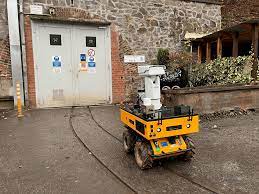Robotics in Mining: Improving Efficiency and Safety
The mining industry is one of the most important sectors of the global economy, providing the raw materials that are essential for manufacturing and construction. However, mining is also one of the most dangerous industries, with workers facing a range of hazards, including cave-ins, explosions, and exposure to toxic chemicals. In recent years, robotics has emerged as a potential solution to improve efficiency and safety in mining operations. In this article, we will explore the ways in which robotics is transforming the mining industry and improving efficiency and safety.
Autonomous Vehicles
One of the most promising applications of robotics in mining is the use of autonomous vehicles. These vehicles, which can be controlled remotely or operate on their own, can perform a range of tasks, including hauling materials, drilling, and blasting. By using autonomous vehicles, mining companies can improve efficiency and productivity while reducing the risk of accidents.
Autonomous vehicles can operate in hazardous environments that are too dangerous for human operators. For example, they can work in underground mines where the risk of cave-ins and explosions is high. They can also operate in extreme weather conditions, such as high temperatures or heavy rain, that would be dangerous for human operators.
In addition to improving safety, autonomous vehicles can also improve efficiency by reducing downtime and increasing productivity. They can operate 24/7 without the need for breaks, reducing the time it takes to complete tasks such as drilling and hauling materials.

Drones and Robotics Inspection
Another promising application of robotics in mining is the use of drones and robotics for inspection. Drones can be used to inspect mines from the air, providing a bird’s-eye view of the operation. This can help mining companies to identify potential hazards and areas for improvement, as well as monitor the progress of mining operations.
Robotics can also be used for inspection of mining equipment and infrastructure. For example, robots can be used to inspect conveyor belts, identifying wear and tear and other issues that could lead to breakdowns or accidents. They can also be used to inspect underground tunnels and shafts, identifying potential hazards such as gas leaks or unstable rock formations.
The use of drones and robotics for inspection can improve safety by reducing the need for human operators to enter hazardous environments. It can also improve efficiency by reducing downtime and increasing the accuracy of inspections.
Automated Drilling and Blasting
Drilling and blasting are essential tasks in mining operations, but they can also be dangerous and time-consuming. The use of robotics for drilling and blasting can improve safety and efficiency by reducing the need for human operators to be present during these tasks.
Automated drilling and blasting can be controlled remotely, reducing the risk of accidents and injuries. It can also improve efficiency by reducing the time it takes to complete these tasks. For example, automated drilling can be more precise and accurate than manual drilling, reducing the need for rework and increasing productivity.
Robotics for Materials Handling
Materials handling is another area where robotics can improve efficiency and safety in mining operations. Automated materials handling can reduce the risk of accidents by eliminating the need for human operators to be present during these tasks. It can also improve efficiency by reducing downtime and increasing productivity.
Robotic materials handling can include the use of automated conveyor belts, robotic loaders, and autonomous haul trucks. These automated systems can operate 24/7 without the need for breaks, reducing the time it takes to transport materials from one location to another.
Challenges of Robotics in Mining
While the use of robotics in mining offers many benefits, there are also challenges that need to be addressed. One of the biggest challenges is the cost of implementing robotics technology. The initial investment required for robotics systems can be high, and mining companies need to carefully evaluate the potential return on investment.

Another challenge is the need for specialized skills and training to operate and maintain robotics systems. Mining companies need to ensure that their employees are trained on how to operate and maintain these systems to ensure that they are used safely and effectively.
Finally, mining companies need to ensure that robotics systems are reliable and can operate in the harsh environments found in mining operations. This requires careful consideration of the design and construction of robotics systems to ensure that they can withstand the conditions found in mines.
Conclusion
Overall, the use of robotics in mining has the potential to transform the industry by improving efficiency and safety. By using autonomous vehicles, drones, robotics inspection, automated drilling and blasting, and robotics for materials handling, mining companies can reduce the risk of accidents, increase productivity, and improve the accuracy of mining operations. However, mining companies must also address the challenges of cost, skills, and reliability to ensure that robotics systems are used safely and effectively. As the technology continues to evolve, we can expect to see even more innovative applications of robotics in the mining industry.
Furthermore, the use of robotics in mining can also have a positive impact on the environment. By using autonomous vehicles and robotics for materials handling, mining companies can reduce the amount of fuel used in mining operations, as well as reduce the emissions of greenhouse gases. This can help mining companies to meet environmental regulations and reduce their carbon footprint.
In addition, robotics can also help to improve the accuracy of mining operations, reducing the amount of waste generated. For example, automated drilling can be more precise than manual drilling, reducing the amount of ore that is wasted. This can help to reduce the environmental impact of mining operations and improve the sustainability of the industry.
Finally, the use of robotics in mining can also help to improve the quality of life for mining workers. By reducing the need for human operators to be present during hazardous tasks, robotics can reduce the risk of accidents and injuries. This can help to improve the safety of mining operations and reduce the physical toll on workers.





















